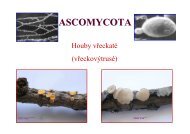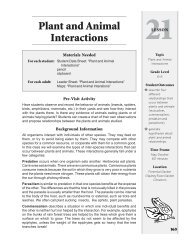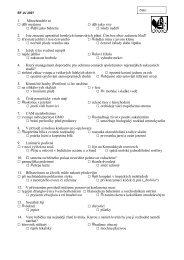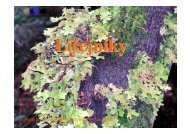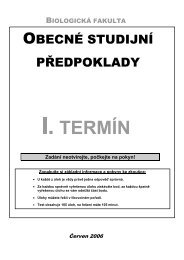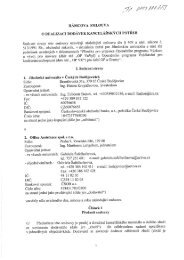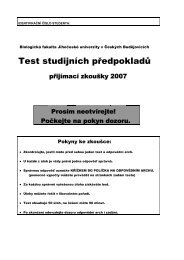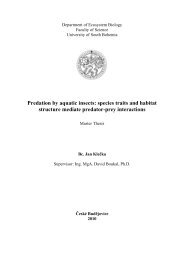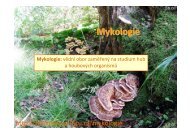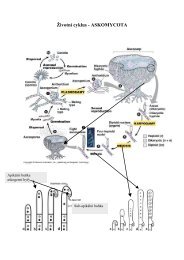The structure and dynamics of a water beetle community in a ...
The structure and dynamics of a water beetle community in a ...
The structure and dynamics of a water beetle community in a ...
Create successful ePaper yourself
Turn your PDF publications into a flip-book with our unique Google optimized e-Paper software.
Light trap<br />
A light trap located near the beg<strong>in</strong>n<strong>in</strong>g <strong>of</strong> the same dra<strong>in</strong> is used for monitor<strong>in</strong>g <strong>of</strong><br />
moths s<strong>in</strong>ce 1981 <strong>and</strong> ma<strong>in</strong>ta<strong>in</strong>ed by Karel Spitzer <strong>and</strong> Josef Jaroš (Jaroš & Spitzer 1999), I<br />
have been obta<strong>in</strong><strong>in</strong>g <strong>water</strong> <strong>beetle</strong>s from this trap s<strong>in</strong>ce 2002, <strong>and</strong> data from 2002–2006 are<br />
used <strong>in</strong> this thesis. <strong>The</strong> trap operates every night from early spr<strong>in</strong>g till the end <strong>of</strong> autumn, <strong>and</strong><br />
captured <strong>in</strong>sects are collected three times a week. Dur<strong>in</strong>g the study period, technical problems<br />
caused several short-term losses <strong>of</strong> data, but the losses are negligible (less than 3% <strong>of</strong> total<br />
sampl<strong>in</strong>g nights).<br />
Box trap<br />
Box trap was used <strong>in</strong> 2004 <strong>in</strong> the outer half <strong>of</strong> the same dra<strong>in</strong>. Six samples were taken<br />
weekly, three <strong>of</strong> them <strong>in</strong> the dra<strong>in</strong> <strong>and</strong> three <strong>in</strong> the flooded area outside the dra<strong>in</strong> <strong>in</strong> the<br />
wetl<strong>and</strong> <strong>in</strong>terior. <strong>The</strong> wetl<strong>and</strong> was divided <strong>in</strong>to three segments perpendicularly to the dra<strong>in</strong>. In<br />
each segment, a pair <strong>of</strong> r<strong>and</strong>omly located samples was taken (one sample <strong>in</strong> the dra<strong>in</strong><br />
adjacent to the bank, one outside the dra<strong>in</strong> up to 20 m apart). A plastic box trap cover<strong>in</strong>g an<br />
area <strong>of</strong> 60 x 40 cm was placed <strong>in</strong>to the <strong>water</strong> <strong>and</strong> the enclosed area was thoroughly swept.<br />
Large plant fragments were sorted out <strong>in</strong> the field; detritus <strong>and</strong> small plant rema<strong>in</strong>s with<br />
collected <strong>beetle</strong>s were taken to the lab <strong>in</strong> cloth bags <strong>and</strong> dried <strong>in</strong> dry extractors consist<strong>in</strong>g <strong>of</strong> a<br />
conta<strong>in</strong>er with a little <strong>of</strong> <strong>water</strong> <strong>and</strong> a tightly fitt<strong>in</strong>g frame with the bottom made from wire<br />
mesh, on which I placed a th<strong>in</strong> layer <strong>of</strong> substratum. <strong>The</strong> upper part was covered by a cloth<br />
<strong>and</strong> the substratum was let to dry for 48 hours. Adult <strong>beetle</strong>s <strong>and</strong> larvae were collected <strong>in</strong> the<br />
lower conta<strong>in</strong>er with <strong>water</strong>.<br />
H<strong>and</strong>net sampl<strong>in</strong>g<br />
St<strong>and</strong>ardized h<strong>and</strong>net sampl<strong>in</strong>g was carried out <strong>in</strong> 2006. Four 20 m long segments<br />
spread regularly over the full length <strong>of</strong> the dra<strong>in</strong> were sampled every two weeks. One<br />
r<strong>and</strong>omly located sample was taken <strong>in</strong> each segment <strong>and</strong> the area <strong>of</strong> approximately 0.5 x 0.5<br />
m adjacent to the bank was thoroughly swept by a h<strong>and</strong>net. Large plant rema<strong>in</strong>s were sorted<br />
out <strong>in</strong> the field <strong>and</strong> s<strong>of</strong>t detritus was preserved <strong>in</strong> 96% ethanol <strong>and</strong> collected <strong>in</strong>vertebrates<br />
were sorted out <strong>in</strong> the lab. This method is conceptually very similar to the box trap <strong>and</strong> was<br />
used to overcome problems with manipulation with box trap <strong>in</strong> the hardly accessible centre <strong>of</strong><br />
the wetl<strong>and</strong>.<br />
2.2.3 Process<strong>in</strong>g material<br />
I have identified all collected <strong>beetle</strong>s to species level, except the larvae <strong>of</strong> Cyphon spp.<br />
<strong>and</strong> a few other larvae, which could be identified only to genus. Adults were divided <strong>in</strong> two<br />
age groups labelled as mature (tough, fully pigmented cuticle on the ventral body side) <strong>and</strong><br />
immature (s<strong>of</strong>t pale cuticle at least on abdom<strong>in</strong>al ventrites). In all species <strong>of</strong> the Dytiscidae,<br />
sex was determ<strong>in</strong>ed us<strong>in</strong>g secondary sexual characters or by extraction <strong>of</strong> genitalia.<br />
Adults are stored dry except those collected by st<strong>and</strong>ardized h<strong>and</strong>net sampl<strong>in</strong>g, which<br />
are stored <strong>in</strong> ca. 80% ethanol as are with the larvae.<br />
2.2.4 Data process<strong>in</strong>g<br />
Unless otherwise stated, data analyses <strong>and</strong> graphs were executed <strong>in</strong> the R 2.6.0<br />
s<strong>of</strong>tware (R Development Core Team 2007). <strong>The</strong> species richness <strong>and</strong> diversity <strong>of</strong><br />
assemblages sampled by <strong>in</strong>dividual methods were analyzed us<strong>in</strong>g EstimateS s<strong>of</strong>tware<br />
(Colwell 2006). Comparison <strong>of</strong> sampl<strong>in</strong>g methods is based only on species with aquatic<br />
adults (light trap collects also species with terrestrial adults). Sample-based rarefaction was<br />
12



